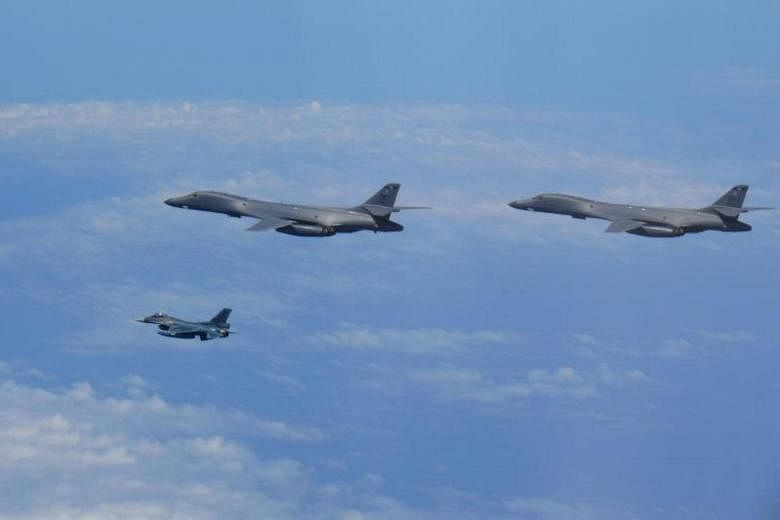SEOUL (AFP) - US bombers carried out a rare live fire drill in South Korea on Saturday (July 8), flying close to the DMZ in a show of force after Pyongyang's latest missile test, the South's defence ministry said.
The exercise by two B-1B Lancers, flown from Andersen Air Base in Guam, was part of a 10-hour mission with South Korean and Japanese fighter jets in response to a "series of increasingly escalatory actions by North Korea including the intercontinental ballistic missile" on Tuesday, US Pacific Air Forces said.
South Korea's Yonhap news agency said the long-range heavy bombers flew close to the tense and heavily militarised land border with the North before turning back.
The exercise aimed to "sternly respond to the series of North Korea's ballistic missile launches", the South's air force said in a statement.
Four US and South Korean jet fighters joined the live fire drill, which was conducted at a range in Yeongwol County, some 80km south of the inter-Korean border, the military said.
The long-range heavy aircraft each dropped a 2,000-pound (907.1kg) laser-guided bunker-busting smart bomb.
The US statement said the B-1Bs released "inert" weapons at the Pilsung Range.
The drill simulated the two US bombers destroying enemy ballistic missile batteries and South Korean jets mounting precision strikes against underground enemy command posts, the South's air force said.
"Through this drill, the South Korean and US air forces demonstrated strong determination to thoroughly punish the enemy for its provocative acts, and showed off their capability to pulverise enemy command posts," it said.
Lieutenant General Thomas Bergeson, US Forces Korea deputy commander, said the mission demonstrated the allies remain "prepared to use the full range of capabilities to defend and to preserve the security of the Korean peninsula and region".
En route back to Guam, the B-1Bs flew and integrated with Japanese fighter jets over the East China Sea, US Pacific Air Forces said in a press statement.
"The US-Japan alliance and the relationship between our militaries are stronger than they have ever been," said Lieutenant General Jerry P. Martinez, US Forces Japan commander. "We continue to train with our Japanese allies to ensure we are ready to defend ourselves from attack", he said.
North Korea on Tuesday test-fired an intercontinental ballistic missile for the first time, an apparent game-changer in its confrontation with Washington over its nuclear and missile programmes.
In response, US and South Korean soldiers fired ballistic missiles simultaneously in a drill on Wednesday, simulating an attack on the North's leadership "as a strong message of warning", the South's military said at the time.
The US Missile Defence Agency said on Friday it would soon test an anti-ballistic missile system in Alaska, days after the North demonstrated its arsenal was capable of striking parts of Alaska with the ICBM test.

